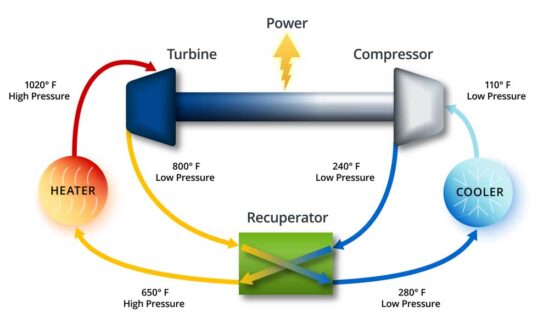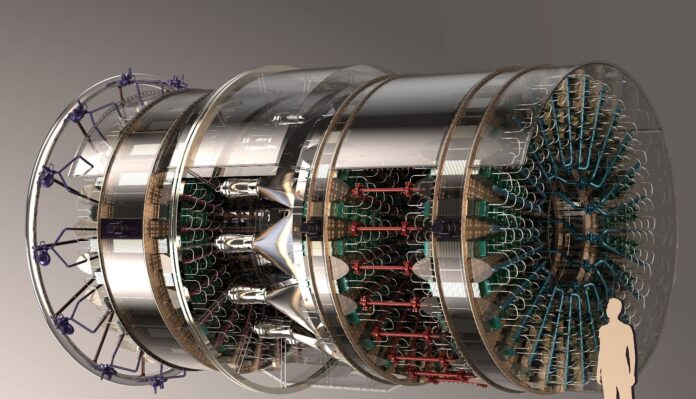Steam turbines in thermal power generation are today’s standard. But pressurized carbon dioxide (CO2) in a closed-loop system could do the job. Supercritical CO2 acting as both a liquid and a gas under extreme pressure would provide the impetus to spin a turbine. Using supercritical CO2 may prove to be far more efficient than steam to provide emissions-free power to the electrical grid. Energy input coming from renewable sources such as wind, solar, geothermal, as well as nuclear power, or even gas or coal-fired thermal energy power plants with accompanying carbon capture technology could be combined with this technology to be an effective addition to energy utilities.
Recently researchers at the Sandia National Laboratory Kirtland Air Force Base in the United States demonstrated a closed-loop Brayton Cycle engine technology as it delivered power to the electrical grid continuously. Sandia has been working with the Brayton Cycle technology for power generation for some time now because it is seen as having significant energy conversion advantages over conventional steam turbines by as much as 50%.
George Brayton, a 19th-century American inventor experimented with internal combustion engines. The Brayton Cycle Engine is his invention dating back to 1878. The engine worked by heating compressed air in a closed space before releasing it to power a rotating shaft. Substitute a turbine for a rotating shaft and you get the picture. States Darryn Fleming, at the US Department of Energy (DOE) Supercritical Transformational Electric Power Program, the Brayton Cycle is “basically a jet engine running in a closed loop with supercritical CO2 as the working fluid.”
Sandia’s use of supercritical CO2 (the gas under very high pressure) is more than just happenstance. Supercritical CO2 is chemically stable, non-flammable, non-toxic, and should increasingly be available as carbon capture projects increased promoted by incentives and subsidy programs contained within the recently US-passed Inflation Reduction Act.

A diagram showing the Brayton Cycle can be seen above. The gas is heated to temperatures much greater than steam at water’s boiling point, 100 Celsius (212 Fahrenheit). In fact, heated CO2 can reach temperatures seven times greater (700 Celsius or 1,290 Fahrenheit). That’s what makes the energy conversion 50% more efficient than using steam which loses as much as a third of its energy potential as it converts back to water during the process.
This past April, a Sandia team heated CO2 to 315 Celsius (600 Fahrenheit), a little less than half the optimal temperature. Their Brayton Cycle engine was able to send continuous power to the grid for 50 minutes. Although only 10 Kilowatt-hours, less than a third of what the average American home consumes in a day, it was the first demonstration of the technology as a reliable energy streaming source for the electrical grid. The test included three controlled shutdowns and restarts and the technology aced it.
Scaling up from 10 Kilowatts to 1 Megawatt appears to be doable by 2024 based on the Sandia Labs team. They plan to double the temperature of the supercritical CO2 in the next iteration of the Brayton Cycle engine. It requires upgrading materials and parts to withstand these changes in heat and pressure. A 1-Megawatt demonstration technology will be enough to power up to 1,000 homes or could be used to replace diesel generators in remote locations such as communities in Alaska or Northern Canada.
The Sandia Labs team goal along with industry partners is to increase the capacity of their Brayton Cycle system to generate up to 5 Megawatt-hours continuously to the electrical grid. They see that as being a technology that grid operators will be more willing to allow. That’s because those operating and maintaining the grid don’t take kindly to anyone disrupting it in any way. For utilities, the work being done at the Sandia Labs could prove to be a game changer in what is a power industry moving away from its heavy reliance on fossil-fuel thermal energy production.
















